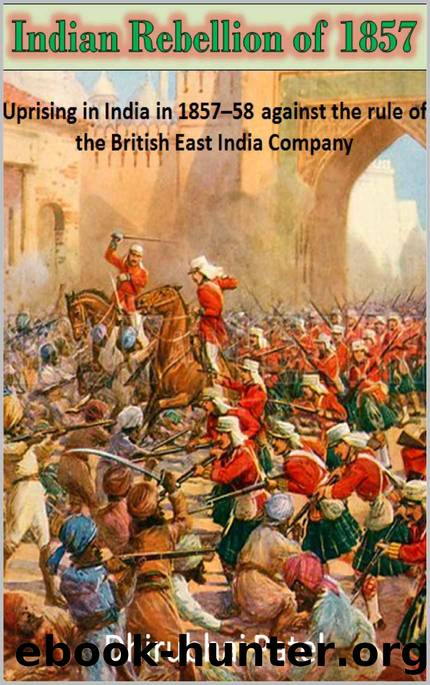Indian Rebellion of 1857 by Patel Dhirubhai

Author:Patel, Dhirubhai
Language: eng
Format: epub
Published: 2020-07-06T00:00:00+00:00
Chapter 10 : Attack of Cawnpore
The Siege of Cawnpore was a key scene in the Indian insubordination of 1857. The blockaded Company powers and regular folks in Cawnpore (presently Kanpur) were caught off guard for an all-encompassing attack and gave up to revolt powers under Nana Sahib, as an end-result of a sheltered entry to Allahabad. Be that as it may, their clearing from Cawnpore transformed into a slaughter, and a large portion of the men were executed. As an East India Company salvage power from Allahabad drew closer Cawnpore, 120 British ladies and kids caught by the Sepoy powers were executed in what came to be known as the Bibighar Massacre, their remaining parts being tossed down a close by well trying to conceal the proof. Following the recover of Cawnpore and the disclosure of the slaughter, the irate Company powers occupied with boundless reprisal against caught rebel officers and neighborhood regular citizens. The killings incredibly disenchanted the British majority against the Sepoy revolts and propelled the call to arms "Recollect Cawnpore!".
Cawnpore was a significant army town for the East India Company powers. Situated on the Grand Trunk Road, it lay on the ways to deal with Sindh (Sind), Punjab and Awadh (Oudh).
By June 1857, the Indian insubordination had spread to a few regions close Cawnpore, to be specific Meerut, Agra, Mathura, and Lucknow. Be that as it may, the Indian sepoys at Cawnpore at first stayed faithful. The British General at Cawnpore, Hugh Wheeler, knew the neighborhood language, had embraced nearby traditions, and was hitched to an Indian lady. He was certain that the sepoys at Cawnpore would stay faithful to him, and sent two British organizations (one every one of the 84th and 32nd Regiments) to attacked Lucknow.
The British unforeseen in Cawnpore comprised of around 900 individuals, including around 300 military men, around 300 ladies and kids, and around one hundred and fifty traders, entrepreneurs, drummers (sales rep), architects and others. The rest were the local workers, who left not long after the beginning of the attack.
On account of a disobedience by the sepoys in Cawnpore, the most reasonable guarded area for the British was the magazine situated in the north of the city. It had thick dividers, plentiful ammo and stores, and furthermore facilitated the nearby treasury. Be that as it may, General Wheeler chose to take shelter in the south of the city, in an entrenchment made out of two dormitory encompassed by a mud divider. There was a military structure site toward the south of Cawnpore, where nine sleeping shelter were being built at the dragoon dormitory. The British warriors thought that it was hard to burrow profound channels, as it was blistering summer season. The zone likewise needed great clean offices, and there was just one well (which would be presented to adversary fire in the event of an assault). Likewise, there were a few structures disregarding the entrenchment that would give spread to the assailants, permitting them to effortlessly shoot down on the safeguards.
Download
This site does not store any files on its server. We only index and link to content provided by other sites. Please contact the content providers to delete copyright contents if any and email us, we'll remove relevant links or contents immediately.
| Central Asia | Southeast Asia |
| China | Hong Kong |
| India | Japan |
| Korea | Pakistan |
| Philippines | Russia |
The Sympathizer by Viet Thanh Nguyen(4308)
The Rape of Nanking by Iris Chang(4140)
World without end by Ken Follett(3432)
Ants Among Elephants by Sujatha Gidla(3417)
Blood and Sand by Alex Von Tunzelmann(3140)
Japanese Design by Patricia J. Graham(3112)
City of Djinns: a year in Delhi by William Dalrymple(2516)
The Queen of Nothing by Holly Black(2499)
Foreign Devils on the Silk Road: The Search for the Lost Treasures of Central Asia by Peter Hopkirk(2434)
India's Ancient Past by R.S. Sharma(2417)
Inglorious Empire by Shashi Tharoor(2396)
Tokyo by Rob Goss(2390)
In Order to Live: A North Korean Girl's Journey to Freedom by Yeonmi Park(2348)
India's biggest cover-up by Dhar Anuj(2319)
Tokyo Geek's Guide: Manga, Anime, Gaming, Cosplay, Toys, Idols & More - The Ultimate Guide to Japan's Otaku Culture by Simone Gianni(2316)
The Great Game: On Secret Service in High Asia by Peter Hopkirk(2305)
Goodbye Madame Butterfly(2208)
Batik by Rudolf Smend(2128)
Living Silence in Burma by Christina Fink(2038)
